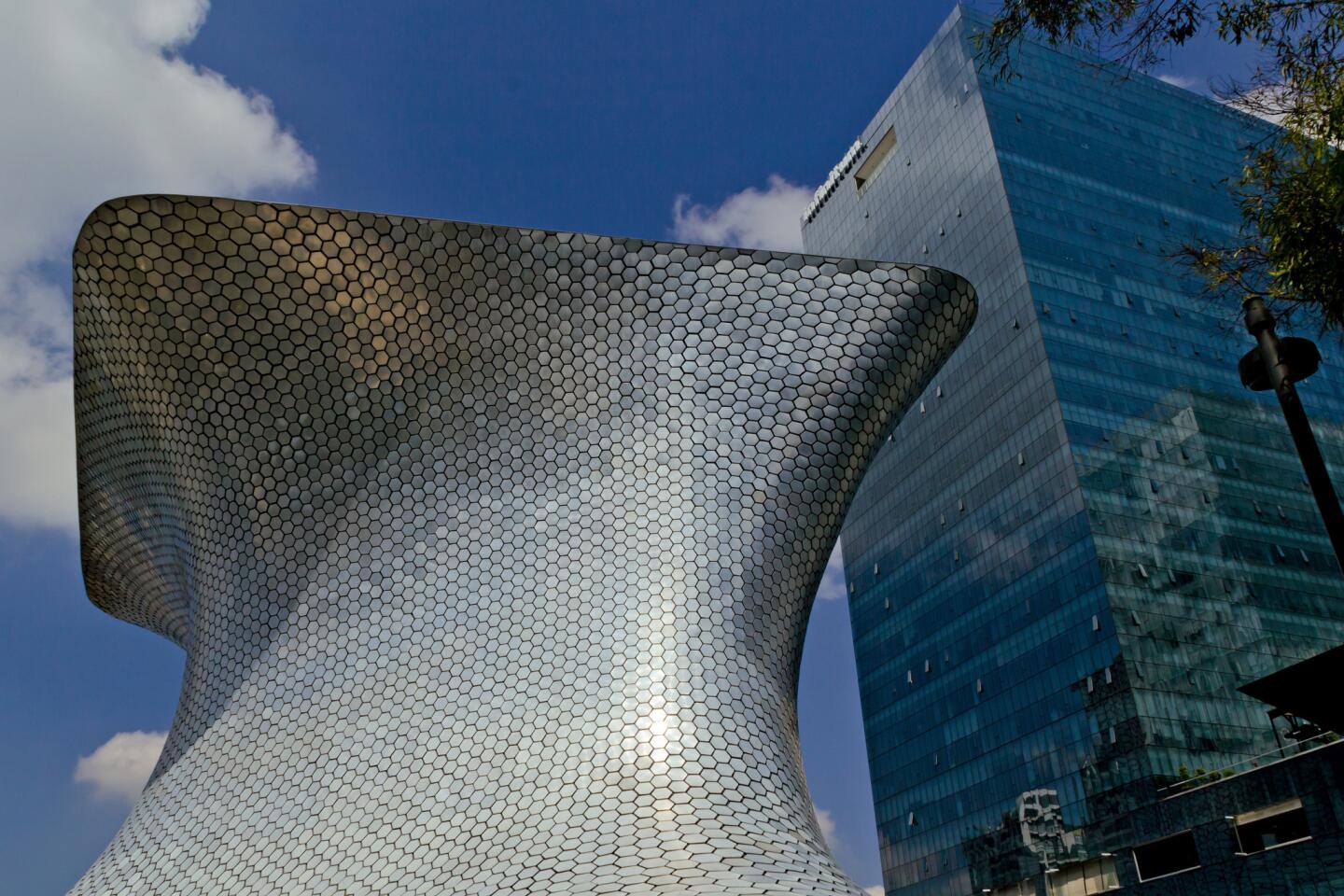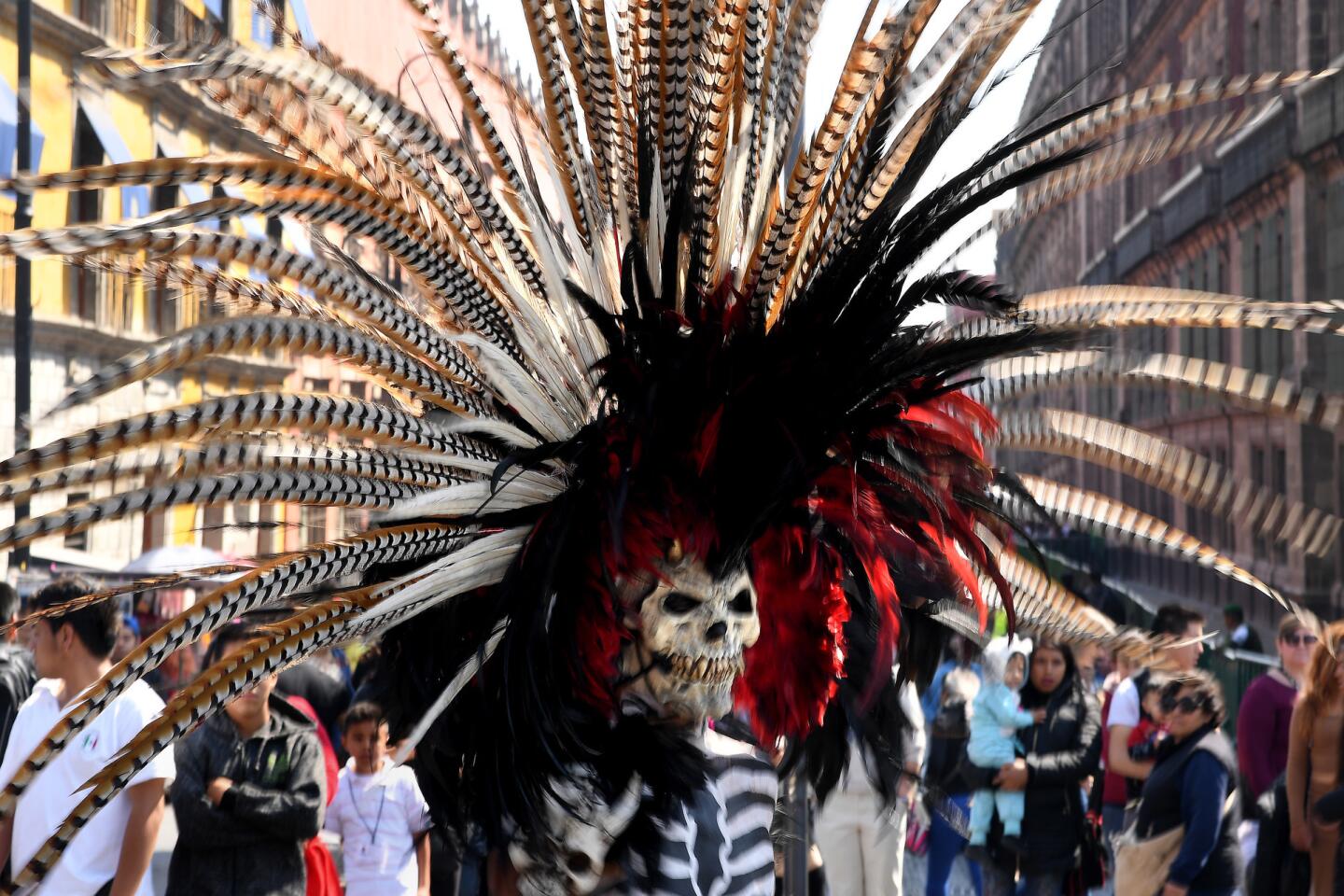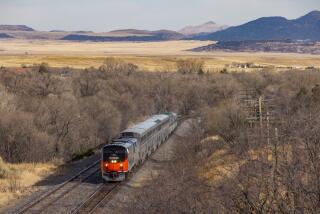Mexico City for beginners

This video races through some of Mexico City’s oldest buildings and most popular visitor destinations, including murals and museums featuring Diego Rivera and Friday Kahlo and floating mariachis.
- Share via
Reporting from Mexico City — Like a lot of Californians, I’ve made dozens of trips to Mexico over the decades — beach resorts in Baja, Maya ruins in the Yucatán, colonial towns in the interior. Yet I’d never made time to explore the capital’s top museums and landmarks, even though their global popularity has boomed in recent years. When I finally gave myself a good look at Mexico City this year, most of those attractions surprised me.
I knew the city’s seismic history but didn’t expect it to show up as dramatically in the Metropolitan Cathedral.
I expected vibrant street life but didn’t anticipate jazz musicians jamming on the sidewalk.
I knew there would be bright colors at Xochimilco but didn’t expect to see so many people having so much fun.
Here, based on my visit in February, is a Mexico City cheat sheet for rookies. Most of these spots are clustered in and around the city’s historic core, and many are accessible on foot from the Plaza de la Constitución — better known as the Zócalo. For car trips, I used ride-share services.
Palacio Nacional
ThePalacio Nacional, east of the Zócalo, is more than the seat of Mexico’s federal government. It’s also home to Diego Rivera’s vision of Mexico. It’s free to see the artist’s epic mural “The History of Mexico,” painted 1929-35, covering four centuries.
If you could see only one mural in Mexico, this is it. Take your time — the walls are dense with imagery, including scenes of pre-colonial village life, the Spanish invasion, cultures and economic theories in violent conflict. Look for Frida Kahlo and Karl Marx (on the left, of course), among others. And remember that this complex of buildings dates to the days of Hernán Cortés, who led the Spanish invasion in the early 16th century.
The Education Ministry, a short walk from the palace, has some of Rivera’s earliest large-scale works, painted between 1923 and 1928, with themes such as labor and revolution.
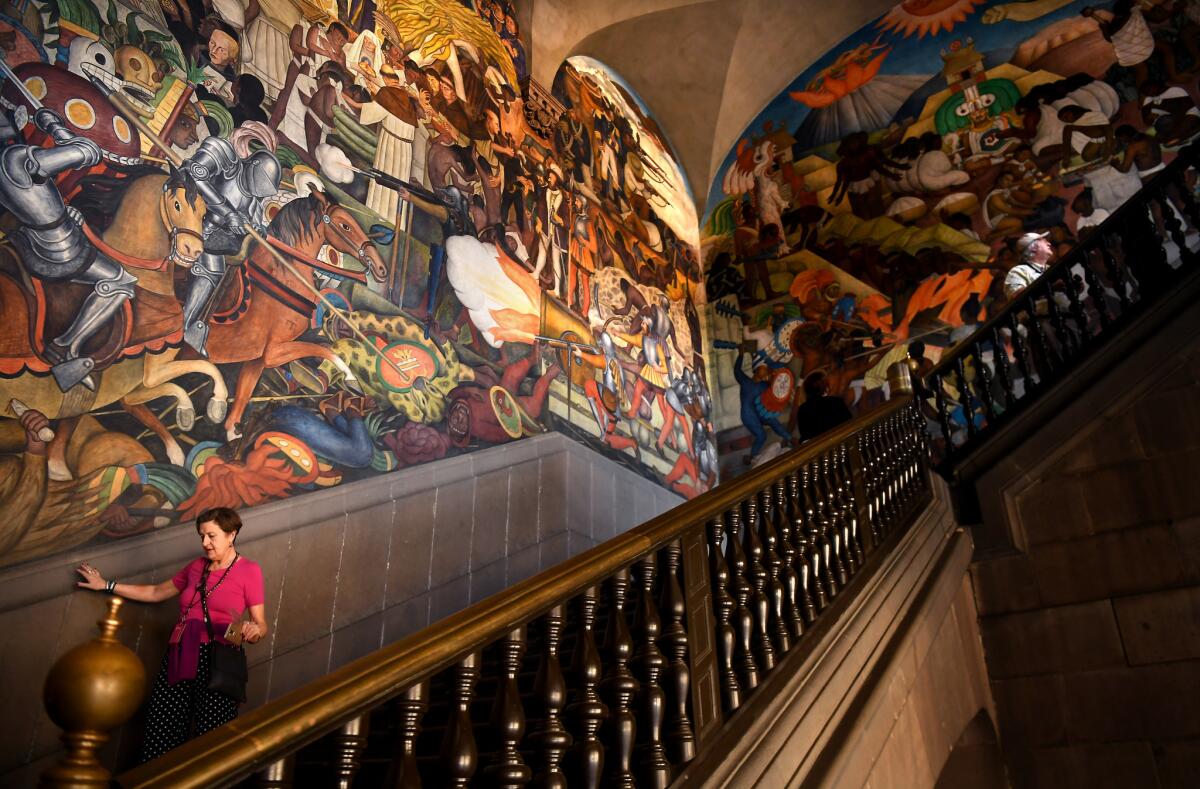
Info: Palacio Nacional. Free with photo ID. Education Ministry. Free with photo ID. I visited both mural sites as part of an escorted 2 ½-hour walking tour ($19) with Mexico a Pie.
Palacio de Bellas Artes
The Palacio de Bellas Artes, perhaps the city’s most-photographed building, is a strange confection. Begun in 1904 and designed by Italian architect Adamo Boari in Art Nouveau and Neoclassical styles, it was not completed until 1934 under architect Federico Mariscal (which helps explain all the Art Deco details inside).
Besides dance, opera and orchestral programs in its theater, the building’s upper levels include murals by Rivera and others, along with a museum of architecture and a Museum of the Palacio de Bellas Artes.

You can cross the street (Eje Central Lázaro Cárdenas) and step into the Palacio Postal, another wonder designed by Boari. I’d call it Mexico City’s answer to the Bradbury Building in Los Angeles, with elaborate ironwork, curving stairs, bronze railings, marble floors, vintage elevators. It’s free.
Another good option, especially after dark, is to cross Avenida Juárez to the Sears department store. Catch the elevator to the eighth floor, grab a drink at the small cafeteria (Finca Don Porfirio) and step outside to the small terrace, where a jaw-dropping urban view will unfold before you: the Palacio de Bellas Artes from above.
Info: Palacio de Bellas Artes. See website for performances. Palacio Postal. Museums closed Mondays.
Casa de los Azulejos
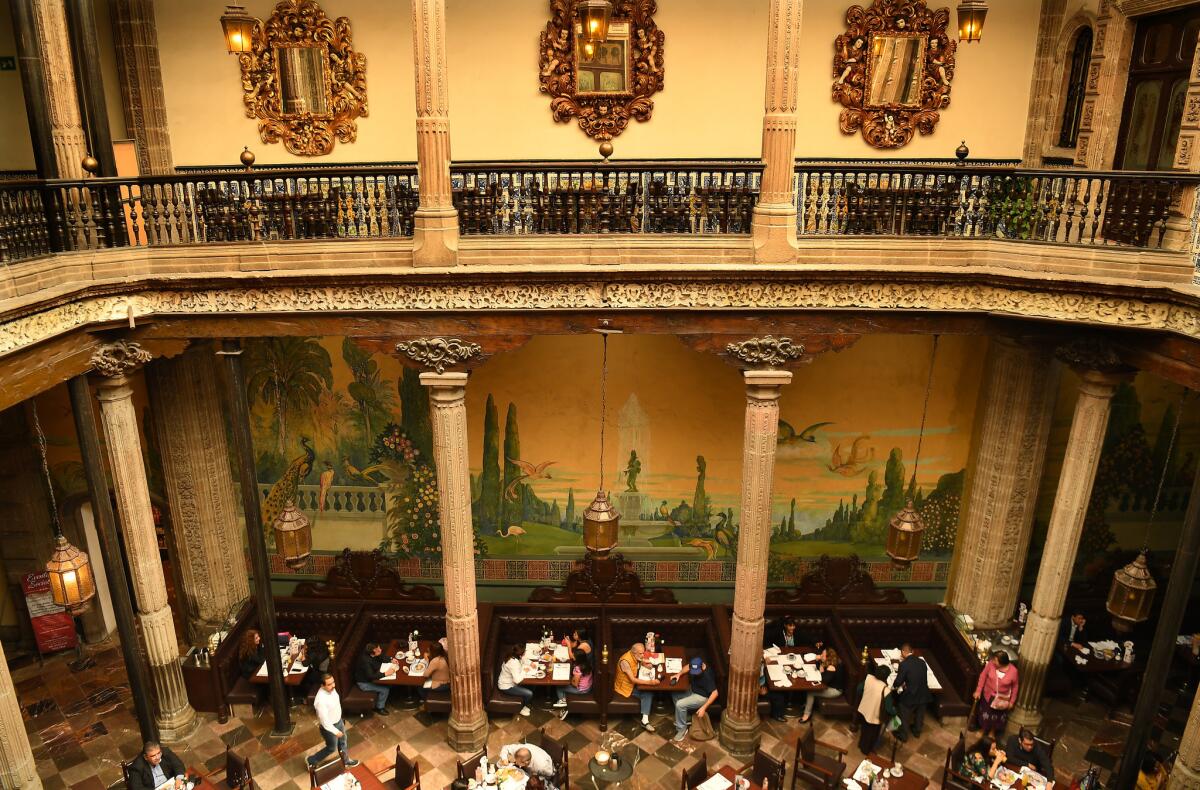
You may not eat especially well in the Casa de los Azulejos, but it’s worth a stop. The casa is a 400-year-old building covered with talavera tile work. Inside there’s a mediocre Sanborns restaurant with tremendous atmosphere — comfortable booths, high ceilings and a great sense of theater. Climb the stairs to take pictures from above, and notice the uneven floors.
I combined my visit with a long walk on Avenida Francisco I. Madero, the pedestrian artery that runs between the Zócalo and Eje Central Lázaro Cárdenas. It’s great people-watching — better than the Zócalo, I decided, because the Zócalo is so massive, with few nooks or crannies.
Info: Casa de los Azulejos. Open daily.
Metropolitan Cathedral

You can’t miss the Metropolitan Cathedral; it faces the Zócalo and it’s big, important and vulnerable. When the Spanish showed up in the 16th century and conquered the Aztec capital, Tenochtitlán, they wanted to make clear they had taken charge. So they started building a cathedral, using native people as slave labor, on the site of the Aztecs’ central temple. As Spain’s ambitions grew, the work continued, on and off, until the early 19th century.
The result is the oldest and biggest cathedral in the Americas, packed with art and gold leaf. But the building is uneven, the result of centuries of earthquakes and the shrinking of the underwater lake beneath Mexico City.
Pace the gently sloping floor and consider the magnitude 8.0 quake that killed thousands on Sept. 19, 1985, and the magnitude 7.1 temblor that arrived 32 years later to the day — Sept. 19, 2017 — killing more than 350 people in the region. As you circulate, you’ll pass five altars and 16 chapels.
Info: Metropolitan Cathedral
Templo Mayor
To learn about what came before the cathedral, proceed to the Templo Mayor archaeological site and museum one block north of the Zócalo and the cathedral. Many of the ruins were uncovered in the 1970s, and there are plenty still being discovered here. In 2017 excavators found a tower of more than 650 human skulls from men, women and children.
Info: Templo Mayor and Museum. Admission about $4 for adults, free for children 13 and younger. Closed Mondays.
National Anthropology Museum
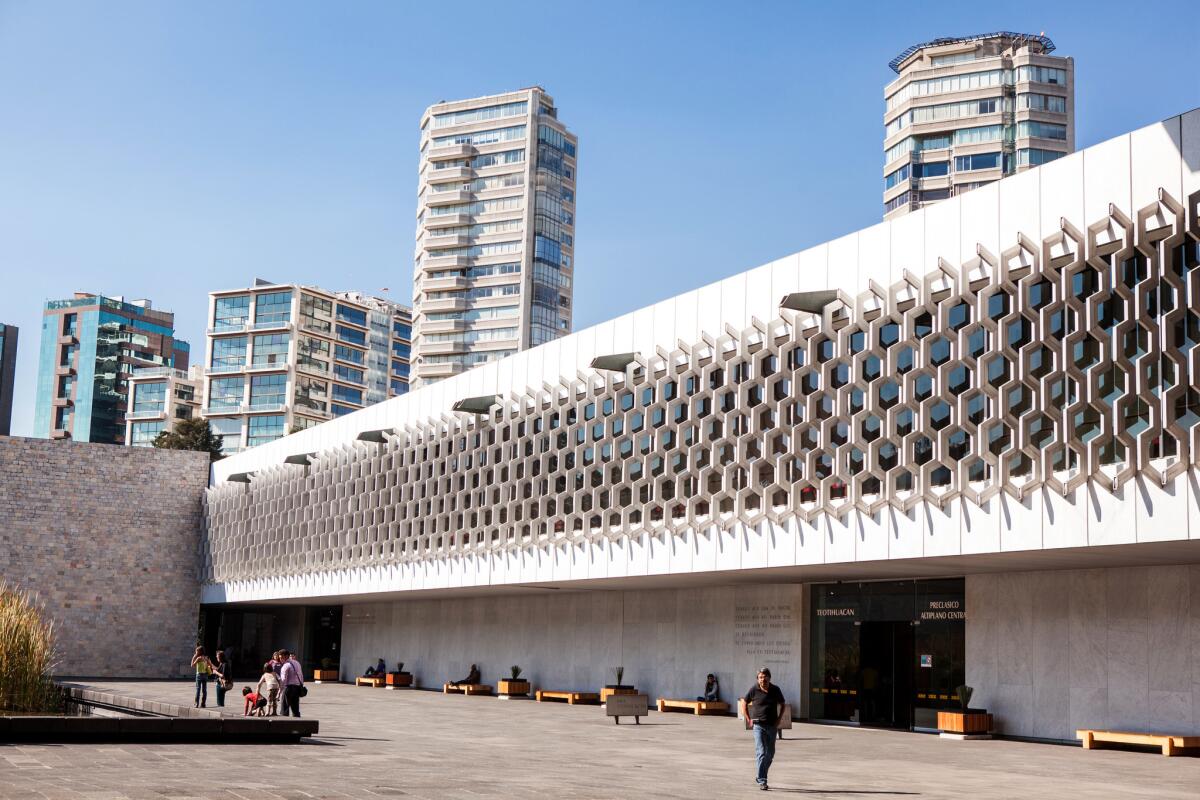
The National Anthropology Museum, about four miles west of the Zócalo in Chapultepec Park, is, oddly, a very 20th century place. Its artifacts, art, models and maps detail Mexico’s regional cultures and the clash of native and Hispanic civilizations that produced them. The long-ago histories are presented within a minimalist behemoth of a building, completed in 1964 with a grand fountain and pond in the middle of a central courtyard.
Info: National Anthropology Museum. Admission is about $4 for adults who are not Mexican citizens. Closed Mondays.
Museo Soumaya

The Museo Soumaya, in the Nuevo Polanco district about seven miles west of the Zócalo, is Mexico City’s answer to Walt Disney Concert Hall — shiny and curvy, with a skin of aluminum scales and a spiral walkway inside that may remind you of the one in the Guggenheim Museum in New York.
The building was bankrolled in 2011 by Carlos Slim, the nation’s wealthiest man, and the collection aims to document 30 centuries of American and European art. Mexican portraits, European Old Masters and Impressionists are featured, as are sculptures by Auguste Rodin. Another important contemporary art museum, Museo Jumex, opened in 2013 a block away.
Info: Museo Soumaya. Open daily; free. Museo Jumex. Closed Mondays. About $2.65 for adults who aren’t Mexican citizens.
Museo Frida Kahlo
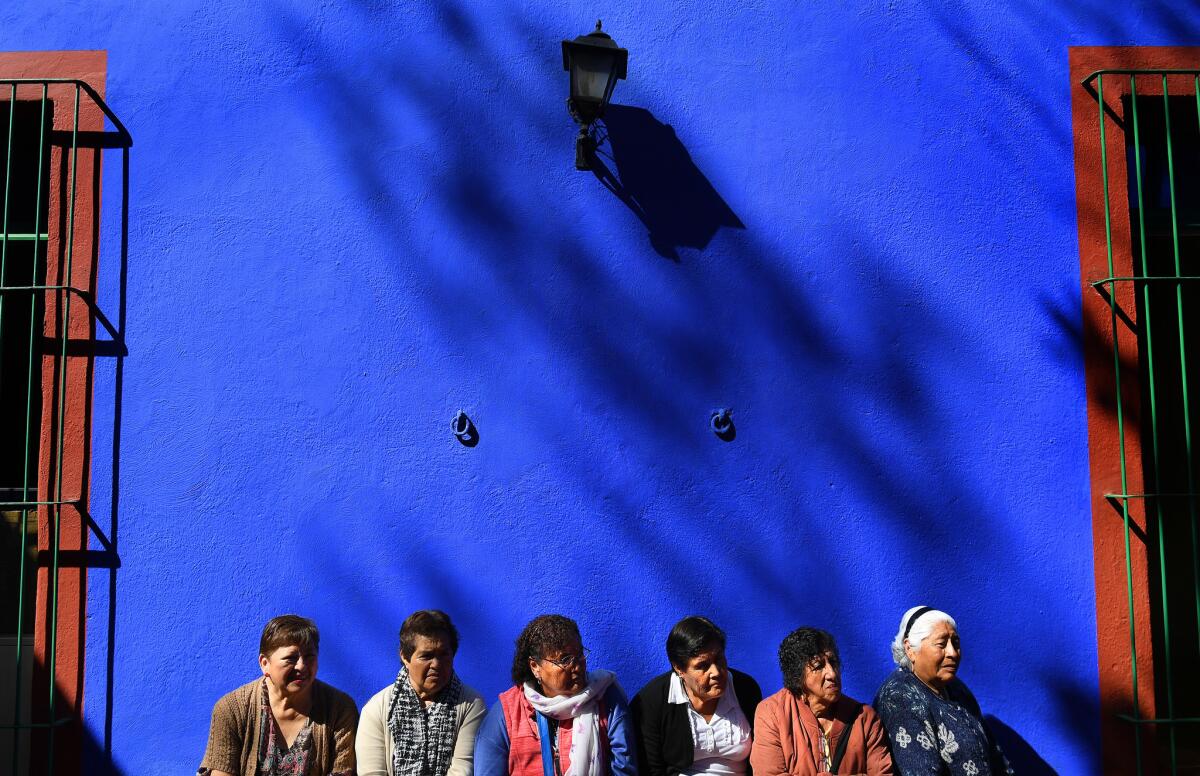
The Museo Frida Kahlo, also known as the Casa Azul for its striking blue walls, has become a tourist magnet in the suburb of Coyoacán, about seven miles south of the Zócalo. It was the artist’s home from 1929 to 1954. There’s often a line, and it gets very crowded, so book in advance. (There are time-specific tickets.) Exhibits include works of art; her studio and colorful kitchen; a pleasant courtyard; a folk art collection; and a death mask of Kahlo. The mask rests upon her bed, staring up at a mirror she used when working on self-portraits — a spooky effect. Big, busy gift shop.
Leave time for a stroll down Calle Ignacio Allende (about six blocks) toward the Plaza Hidalgo and Jardin Centenario at the center of Coyoacán. This is calm, leafy territory compared with the rest of the capital.
Info: Museo Frida Kahlo. Admission is about $12-$14 for adults who are not Mexican citizens. Closed Mondays.
Xochimilco

Xochimilco, where hundreds of red, yellow and blue boats ply miles of canals, is a reminder of the area’s pre-Hispanic days. The foliage along the water’s edge can get ragged and the water supply is dwindling, so this landmark may not last much longer in its current form.
There are 10 piers, plenty of musicians, and many vendors of food and beer. Rent a boat (they’re called trajineras), hire a band for a few songs, eat a lot, and raise a glass to the folks in the next boat.
I boarded at Embarcadero Nuevo Nativitas, about 15 miles south of the Zócalo (which means about an hour of driving). Ask your boatman about the Isla de las Muñecas.
Info: Xochimilco. You can rent a trajinera for about $21-$27 an hour, which gets you an entire boat, with captain and room for more than a dozen people. One trajinera company is Trajineras Xochimilco.
If you go
THE BEST WAY TO MEXICO CITY

From Los Angeles, nonstop service to Mexico City is offered on AeroMéxico, Alaska, America, Delta and InterJet and connecting service (change of plane) on United, AeroMéxico, American and InterJet. Restricted round-trip fares begin at $304, including all taxes and fees.
TELEPHONES
To call the numbers below from the U.S., dial 011 (the international dialing code), 52 (the country code for Mexico) and the local number.
WHAT TO KNOW
You should expect nasty traffic at any hour — yes, even by Los Angeles standards.
Be aware that crime has been rising. Mexico City (population: about 8.9 million) averaged three homicides per day in the first four months of this year.
The U.S. State Department says travelers to Mexico City should “exercise increased caution” and rates the city at level 2 on the department’s 1-4 scale of risk, 4 being the most dangerous.
WHERE TO STAY
Zócalo Central Hotel, 61 Avenida 5 de Mayo; 55-5130-5138. Great location, stylish design, helpful English-speaking staff. Doubles from about $129. The rooftop restaurant, Balcón del Zócalo is excellent.
Gran Hotel Ciudad de Mexico, 82 Avenida 16 de Septiembre; 55-1085-0350. Just off the Zócalo. Great Art Nouveau lobby with Tiffany skylight. Doubles from $129-$190.
WHERE TO EAT
All these restaurants are in Mexico City’s Centro Histórico, except for Mercadoroma in the Colonia Roma, three miles southwest of the Zócalo.
Café de Tacuba, 28 Tacuba; 55-5521-2048. Stately dining room with strolling musicians. Most main dishes $11-$16.
Los Callejeros, 10D Avenida 5 de Mayo;55-5510-1122. Opened in 2016. Great, affordable taqueria, with beef, chicken and pork tacos priced from about 80 cents. Smoothies, too.
Mercadoroma, 225 Calle Querétaro, Colonia Roma Norte; 55-5564-1396. Food hall and gourmet market with several dozen eateries and retailers on two levels. I ate at Reina de La Brasa (queen of the grill), where main dishes are about $7-$9.
christopher.reynolds@latimes.com
Follow Reynolds on Twitter: @MrCSReynolds
More to Read
Sign up for The Wild
We’ll help you find the best places to hike, bike and run, as well as the perfect silent spots for meditation and yoga.
You may occasionally receive promotional content from the Los Angeles Times.







